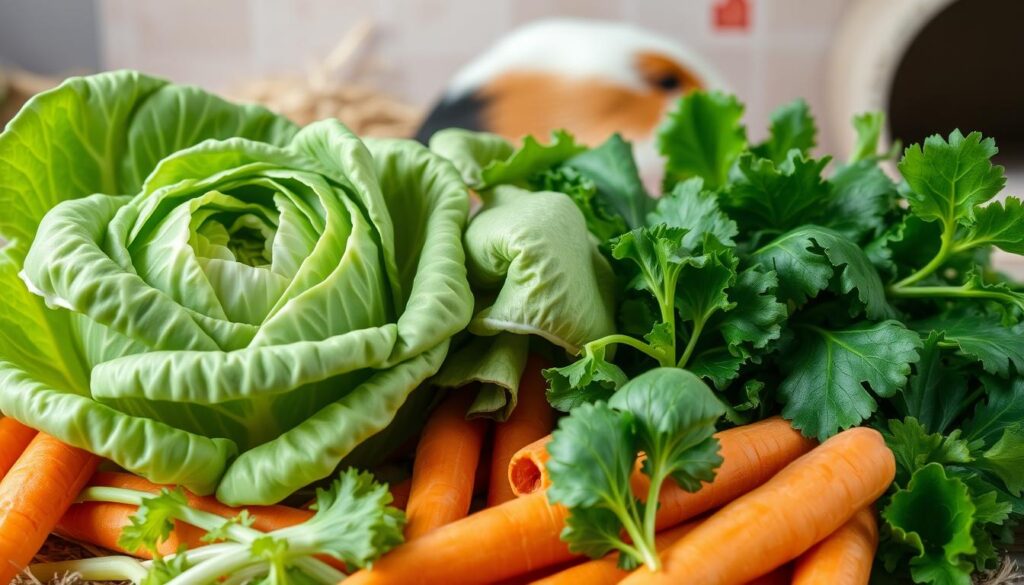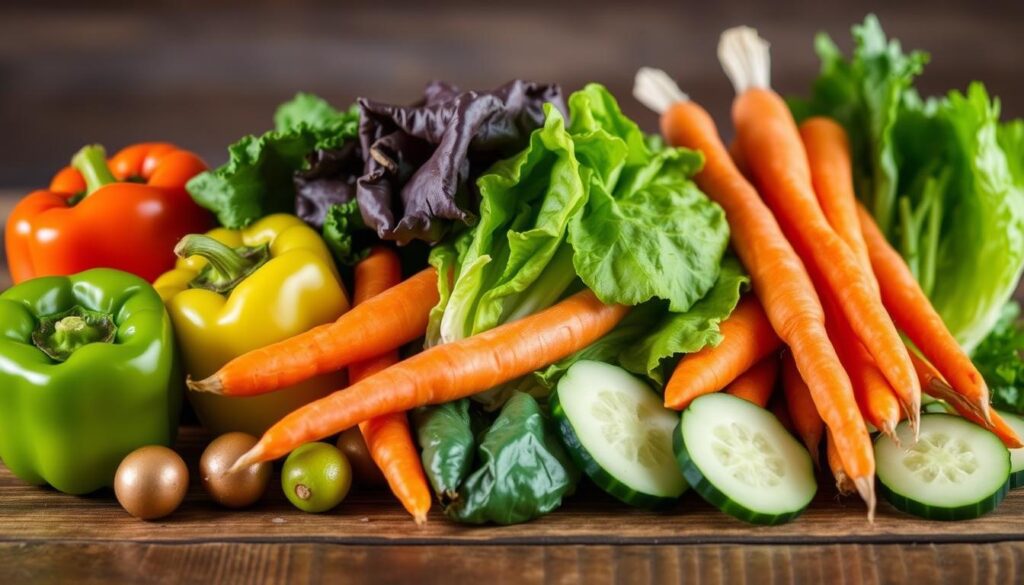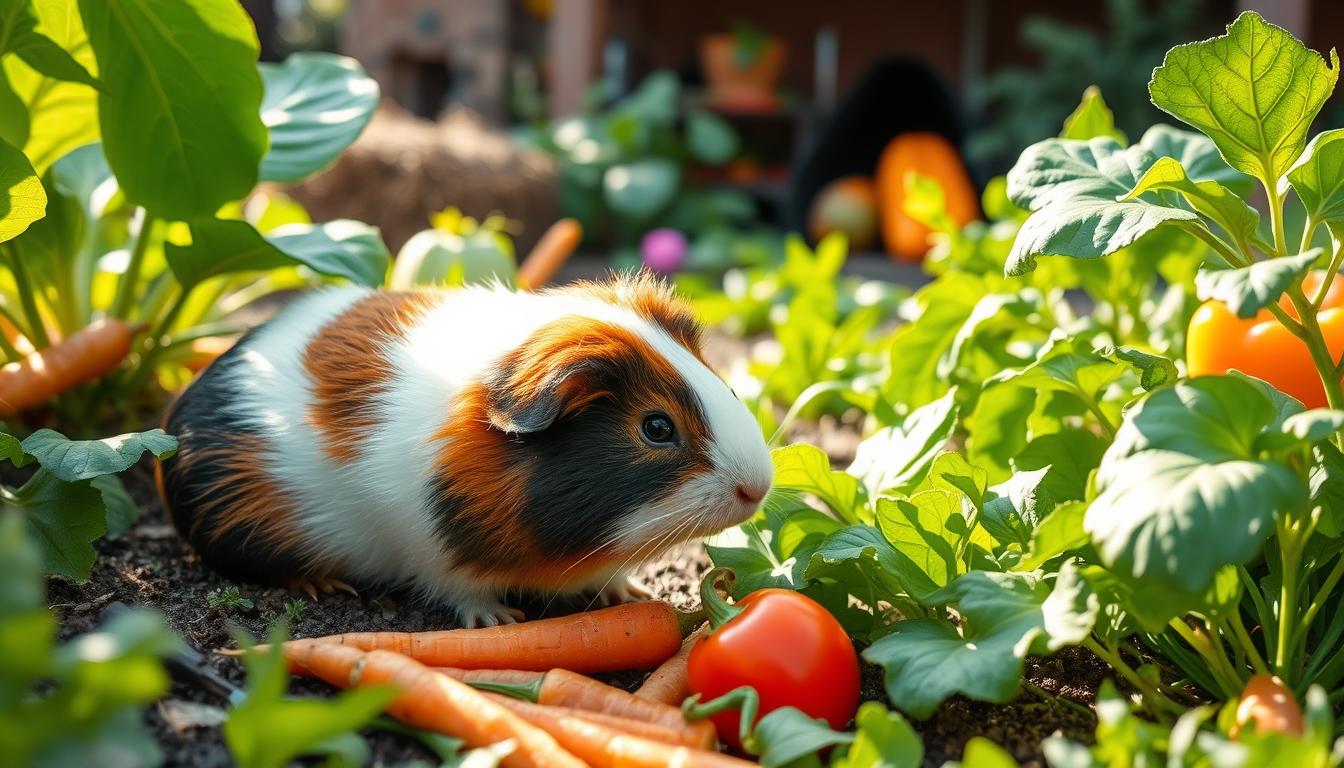As a guinea pig parent, you might wonder if cabbage is safe for your pet. Proper nutrition is key for your cavy’s health. This guide will cover cabbage’s benefits, safe feeding tips, and potential risks.
Creating a balanced diet for your guinea pig is important. With the right info, your cavy can thrive. Let’s explore if guinea pigs can eat cabbage.
Table of Contents
Understanding Guinea Pig Nutrition Basics
Proper nutrition is key for your guinea pig’s health. They need a balanced diet with high-quality foods to stay healthy. Let’s explore the essential nutrients, daily needs, and why vitamin C is crucial.
Essential Nutrients for Guinea Pigs
Guinea pigs need vitamin C, calcium, and fiber. They can’t make vitamin C, so they must get it from food. Calcium helps their bones and teeth, and fiber keeps their digestion healthy. A good diet includes grass hay, pellets, and fresh veggies.
Daily Dietary Requirements
The perfect daily diet for a guinea pig is:
- Unlimited fresh, timothy or orchard grass hay
- 1/8 to 1/4 cup of high-quality, corn-free pellets
- 1/2 to 1 cup of fresh, leafy greens and veggies
The Importance of Vitamin C
Vitamin C is very important for guinea pigs. They can’t make it themselves. Without enough, they might get scurvy, a weak immune system, and other health problems. Make sure their diet has foods rich in vitamin C, like bell peppers, kale, and parsley.
By knowing what your guinea pig needs and feeding them right, you help their health. Always introduce new foods slowly and watch how they do to make sure they’re happy and healthy.
Can Guinea Pigs Eat Cabbage
Yes, guinea pigs can safely eat cabbage as part of their balanced diet. Cabbage is a nutrient-dense vegetable that can provide important vitamins and minerals for your furry friend. However, it’s crucial to introduce cabbage gradually and feed it in moderation to avoid potential digestive issues.
Cabbage is rich in vitamin C, an essential nutrient for guinea pigs. Depending on the variety, a 100g portion of cabbage can contain anywhere from 31mg to 57mg of vitamin C. This makes cabbage a great supplemental source of this vital vitamin, which guinea pigs cannot produce on their own.
| Cabbage Variety | Vitamin C (per 100g) | Fiber (per 100g) | Calcium (per 100g) |
|---|---|---|---|
| Green Cabbage | 36.6 mg | 2.5 g | 40 mg |
| Napa Cabbage | 45 mg | 1 g | 105 mg |
| Red/Purple Cabbage | 57 mg | 2.1 g | 45 mg |
| Savoy Cabbage | 31 mg | 3.1 g | 35 mg |
While cabbage can be a healthy addition to your guinea pig’s diet, it’s important to keep portions small and introduce it gradually. Feeding cabbage once or twice a week is generally recommended, starting with a small amount (such as half a leaf) to avoid digestive upset. Overfeeding cabbage can lead to issues like bloating and diarrhea, so moderation is key.
When offering cabbage to your guinea pig, be sure to thoroughly wash and chop it into bite-sized pieces. Avoid feeding certain varieties, like Napa cabbage, which can be higher in calcium than other types. Sticking to green, red, or Savoy cabbage is generally the safest option.
Remember, a balanced diet for your guinea pig should include a variety of fresh vegetables, fruits, hay, and pellets. Cabbage can be a nutritious addition, but it should not make up the majority of their daily intake. By incorporating cabbage into your cavy’s diet in moderation, you can help support their overall health and well-being.
Benefits of Feeding Cabbage to Guinea Pigs
Adding cabbage to a guinea pig’s diet is very beneficial. It’s packed with vitamins, minerals, and fiber. These nutrients help keep your cavy healthy and happy.
Nutritional Value of Cabbage
Cabbage is a great source of vitamin C. Different types have different amounts. For example, green cabbage has 36.6 mg per 100g. Napa cabbage has 45 mg, red/purple cabbage has 57 mg, and Savoy cabbage has 31 mg.
Guinea pigs need vitamin C because they can’t make it themselves. So, it’s key to get it from their food.
Cabbage also has dietary fiber. This is good for their digestive system. The fiber in cabbage ranges from 1g in Napa cabbage to 3.1g in Savoy cabbage per 100g.
Health Advantages for Your Cavy
- Supports the immune system with its high vitamin C content
- Aids digestion and prevents constipation due to the fiber
- Provides essential minerals like calcium, which is important for strong bones
- May help reduce the risk of heart disease due to the antioxidants in red/purple cabbage
- Low in calories, making it a great option for weight management
Adding cabbage to your guinea pig’s diet can prevent vitamin C deficiency. It also helps with overall health and well-being.
“Cabbage is a nutrient-dense vegetable that can be a valuable addition to your guinea pig’s diet, providing essential vitamins, minerals, and fiber.”
Potential Risks and Precautions
Cabbage can be great for your guinea pig’s diet, but introduce it carefully. Too much cabbage can cause problems like bloating or diarrhea. Start with small amounts and watch how your guinea pig reacts.
Some guinea pigs might not like cabbage as much as others. Watch for signs of discomfort like being tired, eating less, or having loose stools. If you see these signs, stop giving cabbage and talk to your vet.
Always wash and prepare the cabbage well before giving it to your guinea pig. Don’t give them moldy, wilted, or rotten cabbage. Also, some parts of the cabbage plant, like leaves and stems, might be hard for them to digest.
- Introduce cabbage gradually to avoid digestive upset
- Monitor your guinea pig’s reaction and discontinue if any signs of discomfort
- Thoroughly wash and prepare cabbage before feeding
- Avoid feeding moldy, wilted, or rotten cabbage
By being careful and watching your guinea pig’s needs, you can add cabbage to their guinea pig diet safely. This way, they can enjoy the health benefits of cabbage.

How to Introduce Cabbage to Your Guinea Pig’s Diet
Adding cabbage to your guinea pig’s diet is a good way to give them important nutrients. But, you should introduce it slowly to prevent stomach problems. Start by washing the cabbage well and giving it to your cavy raw.
Proper Preparation Methods
Before giving cabbage to your guinea pig, wash it well under running water. This removes any bad stuff or dirt. Since guinea pigs like crunchy foods, you can give it to them raw.
Serving Size Guidelines
Begin with a small amount, like a small leaf or 1-2 square inches, of cabbage. Offer it 2-3 times a week. Slowly increase the amount over 2-4 weeks. Aim for no more than 1/8 cup a day as part of their veggies.
Make sure to take away any leftover cabbage after an hour. This prevents it from getting spoiled.
Frequency of Feeding
For the best health, give cabbage to guinea pigs once or twice a week. Don’t overdo it, as too much can cause problems like bloating or diarrhea. It can even lead to kidney stones or urinary infections.
By following these steps for adding guinea pig cabbage portions, you can safely add this healthy veggie to your cavy’s guinea pig vegetable feeding guide. This will help keep them healthy and happy.
Every guinea pig is different, so watch how they react to cabbage. Adjust how much and how often you give it to them as needed. If you have any worries or questions, talk to your vet about guinea pig vegetable feeding guide.
Other Safe Vegetables for Guinea Pigs
Feeding your guinea pig a variety of foods is important. Cabbage is good, but there are many other safe veggies too. These include leafy greens and crunchy veggies that are great for a balanced meal.
- Romaine lettuce
- Red and green leaf lettuces
- Kale
- Cilantro
- Parsley
- Red or green peppers
- Broccoli
You can also add carrots, zucchini, tomato, and sweet potato to their diet. But, give these only once or twice a week. A mix of leafy greens for cavies gives your guinea pig important vitamins, minerals, and fiber.
| Vegetable | Frequency | Nutritional Benefits |
|---|---|---|
| Romaine Lettuce | Daily | High in vitamins A, C, and K, as well as folate |
| Kale | 2-4 times per week | Rich in vitamins A, C, and K, calcium, and fiber |
| Carrots | 1-2 times per week | Excellent source of beta-carotene and vitamin A |
| Broccoli | 2-4 times per week | High in vitamins C, K, and fiber |
Always introduce new foods slowly and watch how your guinea pig reacts. A mix of safe vegetables for guinea pigs keeps them healthy and happy.

Signs of Digestive Issues to Watch For
As guinea pig parents, it’s important to watch for digestive problems in your pets. After adding cabbage or new foods to their diet, look out for common symptoms. These signs might mean your guinea pig has a digestive issue.
Common Symptoms
- Diarrhea
- Bloating
- Loss of appetite
- Lethargy
If you see these signs, stop the new food right away. Watch your guinea pig closely. They can get very sick if they don’t eat, so act fast.
When to Contact a Vet
If the symptoms get worse or don’t go away, call your vet. They can help fix the problem and keep your guinea pig healthy. Quick action is key to avoiding and fixing digestive issues.
By watching your guinea pig’s health and acting fast, you can keep them happy and healthy. A balanced guinea pig diet and careful food introduction can prevent many problems.
Creating a Balanced Diet Plan
Creating a healthy diet plan is key for your guinea pig’s well-being. Start with unlimited, high-quality timothy hay, making up 80-90% of their diet. Add a small amount of guinea pig-specific pellets, about 1/8 cup daily, for vitamins and minerals.
Include a variety of fresh veggies in their diet for nutrients. Leafy greens like romaine lettuce and kale are great. Also, bell peppers, peas, and cucumber slices are good choices. Always introduce new foods slowly to prevent digestive problems. Avoid too much cabbage, as it can cause bloating.
Make sure to include foods rich in vitamin C, like bell peppers and kiwi. Keep a regular feeding schedule and check your guinea pig’s weight often. This ensures they stay healthy. Adjust their food portions based on their individual needs and health.


1 thought on “Can Guinea Pigs Eat Cabbage: A Safe Feeding Guide”